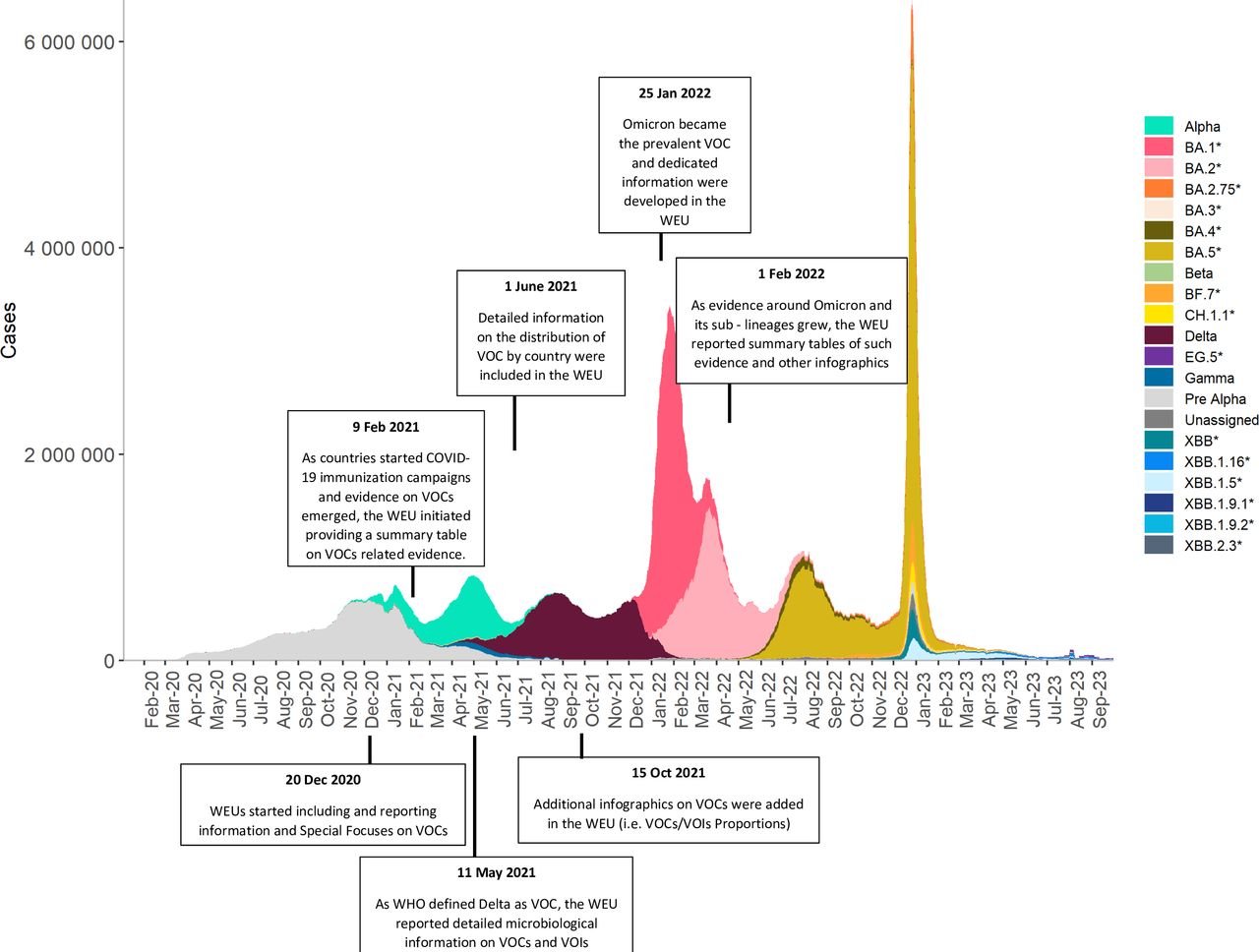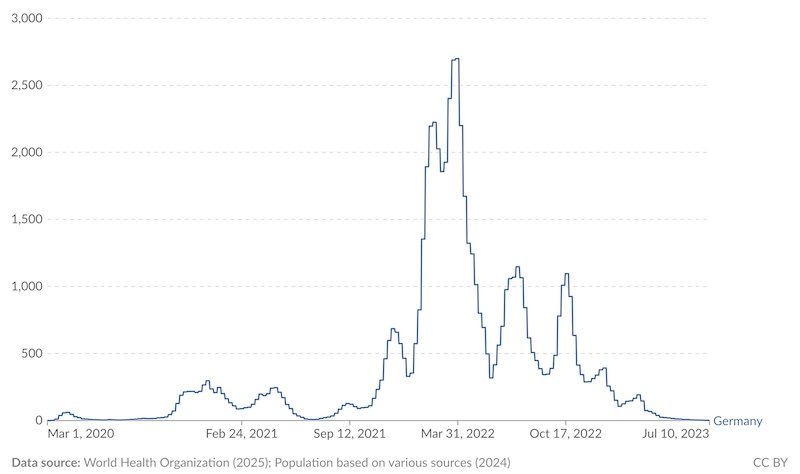
Misrepresents source: The study cited in support of the claim analyzed how COVID-19 and other factors like influenza and heat contributed to excess mortality in Frankfurt during the pandemic. But it didn’t examine the impact of vaccination nor the relationship between mortality and vaccination status.

FULL CLAIM: Scientists alert about “[E]vidence buried in the German government’s official data that confirms excess deaths were caused by mRNA ‘vaccines’ and not Covid.”
REVIEW
In March 2025, viral social media posts shared a screenshot of an article’s headline claiming “Germany Confirms mRNA ‘Vaccines’ Killed More People Than Covid”. One example posted on Facebook accumulated more than 200,000 views at the time of writing.
The article in question was published on Slay News on 10 March 2025. It claimed that scientists in Germany confirmed that “excess deaths were caused by mRNA ‘vaccines’ and not Covid”. It added that “Covid mRNA ‘vaccines’ had weakened immune systems, making influenza infections significantly more deadly for the ‘vaccinated'”. A link in the article sent us to a study published in GMS Hygiene and Infection Control on 4 March 2025.
Slay News is an anonymous website that Media Bias/Fact Check classifies as a questionable source “based on the promotion of conspiracy theories, pseudoscience, right-wing propaganda, poor sourcing, lack of transparency, failed fact checks, and blatant plagiarism”. Science Feedback previously fact-checked other claims by Slay News that falsely blamed COVID-19 vaccines for deaths based on flawed data analyses and misrepresented studies.
As on these previous occasions, the study cited in the Slay News article also didn’t support the claims made.
At no point did the study evaluate the impact of COVID-19 vaccination on excess mortality or attribute the excess mortality it observed to COVID-19 vaccines. The article completely misrepresents the objective and results of the study, which analyzed how COVID-19 and other factors contributed to excess mortality in Frankfurt am Main, Germany, during the COVID-19 pandemic. We explain why.
What did the study do and what did it find?
The study was titled “Mortality in Frankfurt am Main, Germany, 2020–2023: higher excess mortality during an influenza wave in 2022 than during all COVID-19 waves altogether”. Using official population, mortality, and healthcare data, the study analyzed all-cause excess mortality in Frankfurt between 2020 and 2023.
Excess mortality is defined as a greater-than-expected number of deaths within a period of time, relative to the same period in previous years.
The authors adjusted the data for age and trends in population size, and estimated excess mortality for each year between 2020 and 2023 and for the specific periods of each COVID-19 wave (Figure 1). Then, the authors identified potential factors that might have contributed to mortality during those periods, including not only COVID-19 but also other factors like influenza and heat.

Figure 1 – Timeline of global laboratory-confirmed COVID-19 cases from January 2020 to September 2023. Peaks in COVID-19 cases represent COVID-19 waves, with each dominant SARS-CoV-2 variant shown in a different color. Source: Ikejezie et al.[1].
When considering yearly data, the researchers only observed a significant increase in excess mortality of 2.9% (185 more deaths than expected) in 2022, but not in 2020 and 2021. In 2023, the data showed fewer deaths than expected (negative excess mortality). This absence of excess deaths in 2023, when over 77% of the German population had received at least one dose of a COVID-19 vaccine, is at odds with the claim that COVID-19 vaccines cause or increase the risk of death.
According to the authors, the excess mortality observed in 2022 couldn’t be explained by COVID-19 deaths, which were low at that time. Instead, they found that this specific increase in mortality was associated with a short, intense wave of influenza that spanned the last six weeks of 2022. The excess mortality rate during that six-week period was 25% (188 more deaths than expected).
When analyzing COVID-19 waves specifically, the authors found that the first four waves of the pandemic together were associated with an overall small increase in excess mortality of 2.3% (189 more deaths than expected).
Individually, only the second wave at the end of 2020, when the original Wuhan SARS-CoV-2 variant was predominant, was associated with an excess mortality of 10.6% (274 more deaths than expected). Neither the first wave nor the waves that came in 2021, 2022 (Alpha and Delta variants), and 2023 (Omicron variants) were associated with any significant excess mortality in Frankfurt, despite a high number of reported COVID-19 cases.
Therefore, contrary to the Slay News article’s claim, the study showed that COVID-19 waves were indeed associated with a small increase in mortality in Frankfurt. However, the authors found that excess mortality was higher during the 2022 influenza wave than in any wave of the COVID-19 pandemic (31 excess deaths per week compared to 14 excess deaths per week during the second COVID-19 wave), and also higher than in all pandemic waves from 2020 to 2023 together.
Study didn’t evaluate impact of COVID-19 vaccines on mortality; available evidence shows vaccination prevented deaths
As explained in previous Science Feedback reviews, available evidence shows that COVID-19 vaccines reduced excess mortality instead of increasing it.
The study cited by the Slay News article to support its claim didn’t show that mRNA COVID-19 vaccines caused deaths nor that they weakened the immune system, because the study didn’t address vaccination at all.
It is also false that “excess mortality rates did not rise during the first waves of the pandemic” and only “skyrocket[ed]” following the rollout of COVID-19 vaccines, as the article claimed. As we explained above, the researchers observed excess mortality during the second COVID-19 wave, at the end of 2020. As the authors explicitly stated, this was “before vaccination was introduced”.
While the authors found a second period of excess mortality in 2022, they attributed it to an intense wave of influenza, which according to the study, caused a rise in cases and deaths at the national level. The study also didn’t show that flu deaths occurred disproportionately among the vaccinated, as the Slay News article asserted.
In fact, the study’s Discussion specifically stated that their findings didn’t show a correlation between vaccination and excess mortality:
“Kuhbandner and Reitzner described a sudden increase in excess mortality in Germany from April 2021 and proposed possible vaccination (side) effects as the cause. Based on our data this cannot be confirmed, because a comparable increase was not seen in Frankfurt am Main.”
“Kuhbandner and Reitzner” refers to a study published in Cureus in 2023 that suggested a link between COVID-19 vaccination and deaths based on a correlation between the number of vaccinations and excess mortality in Germany between 2021 and 2022. EU factcheck, a project by the European Journalism Training Association, explained that this correlation is flawed because many other factors that the authors didn’t take into account can influence mortality in a population. For example, the study ignored the fact that SARS-CoV-2 infections also increased during the same period, possibly increasing hospitalizations and deaths (Figure 2).
The study by Kuhbandner and Reitzner was later refuted in a 2023 analysis (in German) by the Barmer Institute for Health System Research, showing that over three-quarters of the excess mortality in Germany was associated with a prior COVID-19 infection.

Figure 2 – Daily number of new confirmed COVID-19 cases per million people in Germany between March 2020 and July 2023. Daily cases are presented as the average of the previous seven days (rolling 7-day average). Source: Our World in Data, retrieved on 24 March 2025.
In summary, the study cited by Slay News analyzed excess mortality in Frankfurt between 2020 and 2023. However, it didn’t evaluate the impact of vaccination on excess mortality, nor did it examine the relationship between mortality and vaccination status. Therefore, this study doesn’t support the claim that excess deaths resulted from mRNA vaccination and not COVID-19 deaths.
COVID-19 vaccines have been instrumental in helping control the spread of COVID-19 and reducing the number of cases, hospitalizations, and deaths. Estimates suggest that, rather than causing deaths, COVID-19 vaccines saved more than 1.4 million lives in Europe alone[2] and over 14 million worldwide only during the first year after COVID-19 vaccines became available[3].
REFERENCES
- 1 – Ikejezie et al. (2024) Informing the pandemic response: the role of the WHO’s COVID-19 Weekly Epidemiological Update. BMJ Global Health.
- 2 – Meslé et al. (2024) Estimated number of lives directly saved by COVID-19 vaccination programmes in the WHO European Region from December, 2020, to March, 2023: a retrospective surveillance study. The Lancet Respiratory Medicine.
- 3 – Watson et al. (2022) Global impact of the first year of COVID-19 vaccination: a mathematical modelling study. The Lancet Infectious Diseases.


